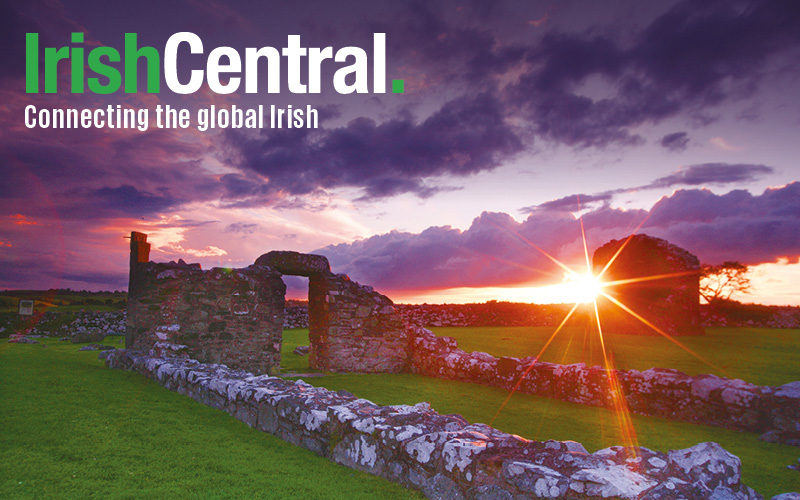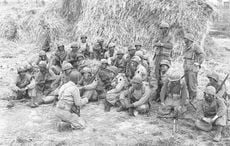Hundreds of Montreal Irish and their supporters marched on Sunday to commemorate the 6,000 Great Hunger victims buried near Victoria Bridge. They also marched to protest. The community is up in arms over the ongoing lack of investment in the current memorial, known as “The Black Rock,” and the fact that the land on which it stands has recently been sold to Hydro-Quebec, which plans to build an electrical substation on the plot.
The massive engraved boulder was the first memorial to the Great Hunger anywhere in the world. It was installed in 1859 in the median of Bridge Street. On Sunday hundreds marched from St. Gabriel’s Church, two kilometers (1.5 mi) to the rock. The march is a 152-year-old annual tradition, the “Walk to the Stone.”
In their speeches, Irish community leaders praised the Catholics and Protestants, anglophones and francophones who had aided victims of the Great Hunger. Outside of Ireland Montreal is home to the largest burial ground of Irish famine victims.
Speaking at the Rock, the Director of the Montreal Monument Park Foundation, Fergus Keyes, said, “Look at the area around the rock that’s supposed to be upkept by the city of Montreal – the fence is all rusted, the plaque is cracked. Nobody seems to care.”
Keyes and other members of the Irish community have been petitioning for a new monument on the site since 2012.
“At least now, thanks mainly to the attention the media have given to (the need for an appropriate memorial), I think something may happen,” Keyes said.
“Maybe it’s a blessing in disguise. Maybe Hydro and other people involved on a political level realize that this is an important issue.”
Last Friday the Irish community had some good news as Hydro-Québec announced that it will “establish a partnership with Montreal’s Irish community” to create a commemorative park for those Irish buried in the area.
Hydro-Québec has also agreed to carry out archaeological surveys of the land. The utility company will try to determine whether Irish bodies were buried in the area before they begin to build.
What’s more, Keyes added, Hydro-Québec “didn’t seem to object to maybe some sort of interpretation center” close to the substation, he added.
The company’s facility will power the planned Réseau électrique métropolitain light rail project. The project is scheduled for completion in 2023.
The Mayor of Montreal Denis Coderre told reporters on Sunday that the city is committed to providing a memorial for the site. He also rejected the implication that the city had done little to help the Irish community’s cause.
“When we say that nothing was done before, that’s not accurate…I met people, people know exactly what I was doing. It’s not a matter of ‘You did nothing.’ I think everybody now understands the importance of everybody working together,” said Coderre.
When asked about the rundown Rock he said, “I’m not going to reinvent the past. I’m looking ahead to make things work.”
Among those present on Sunday was Quebec Native Affairs Minister Geoffrey Kelley, whose great-great-grandfather, a doctor, helped tend to the sick Irish immigrants. He told the Montreal Gazette he had spoken with Pierre Arcand, the minister responsible for Hydro-Quebec.
Kelley said, “there’s a willingness among everyone concerned to find an appropriate solution, an appropriate way to commemorate the people who died there.”
Thomas Mulcair, leader of the federal New Democratic Party and also of Irish descent, said he believes the Prime Minister of Canada Justin Trudeau should step in to stop the sale of the land.
He said, “We were all pleased to see Mr. Trudeau in the St. Patrick’s Day parade this year… That heightens our disappointment that Mr. Trudeau’s government would allow this to go through.”
The site is home to the remains of 6,000 people who died in the Canadian city after fleeing hunger and poverty in Ireland. The mass grave is in an industrial zone at the foot of the Victoria Bridge in Montreal and there is little obvious sign of its significance.
Read more: Montreal’s Irish fight for memorial to the 6,000 famine immigrants who died of typhus
Many Irish lost their lives here during the typhus epidemic of 1847, the year known as Black ‘47 in Irish history, the worst year of the Great Irish Famine.
Due to the lack of information on the symptoms of typhus, many sick people were considered healthy and allowed to continue on their journey from the Canadian quarantine station at Grosse Ile to the next stop of Point St. Charles in Montreal.
The city was not prepared for the throngs of sick and dying Irish, however, in what was to be one of the hottest summers on record in Montreal. By the end of this “Calcutta summer,” 6,000 people had lost their lives, including many Canadians who had ventured into the Irish neighborhoods in an attempt to save the famine refugees.
Despite being the largest single burial site from the Great Hunger outside of Ireland, the grave is currently only marked with a 10-foot tall, engraved stone stained black by car fumes and nicknamed the Black Rock. As such, the Irish in the area established the Montreal Irish Memorial Park Foundation in 2012 with the aim of turning a nearby parking lot into an official memorial to the thousands of Irish buried here and the Canadians who helped them.
The foundation has spent the past five years in discussions with politicians and thought they were near a breakthrough on the site, but the announcement of the sale of the land two weeks ago came as a massive blow.
“After all, we have met with every level of government, from the local borough mayor right up until the local MP, Marc Miller, so repeatedly that these guys know our shirt size. And they promised that they would keep us in the loop,” Victor Boyle, national president of the Ancient Order of Hibernians and a director of the Montreal Irish Monument Park Foundation, told the Montreal Gazette, last week.
“There’s 6,000 people buried around where the stone sits right now, and look what we have for a memorial.”
“Much as the tragedy of what took place in 1847 is an Irish story, the bigger story is the number of Montrealers — French, English, Protestant, Catholic, Jewish, that all came down to that site, that horrible site. It was mired in mud and sickness and disease, it was the hottest summer on record, yet all these people came from their homes and went down to see if they could help,” Boyle continued.
“The story that we’re hoping to preserve is one that Canada sticks to today. Look at the refugees that we accepted from Syria. The rest of the world was holding them at arm's’ length and we embraced them, just like we did the Irish in 1847. That’s the story we want to preserve.”
After the 1840s, the location of the mass Irish grave had been all but forgotten until construction work began on the Victoria Bridge in 1859. It was these workers who honored the Irish by erecting the Black Rock and every year since 1865, a ceremony led by the Ancient Order of Hibernians has included a walk to the Rock as a sign of remembrance of the typhus victims.
Read more: Montreal ‘Walk to the Stone” commemorates 6,000 Irish famine victims
The Memorial Park Foundation had originally set 2017, the 375th anniversary of the founding of Montreal, as the deadline by which they would have established the new memorial – planned to include a museum, monument, meditation areas, a GAA Irish sports field and a beautiful green space that would double as a stunning entryway to the city from the Victoria Bridge.




Comments